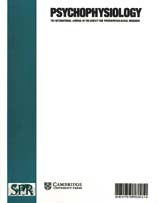Crossref Citations
This article has been cited by the following publications. This list is generated based on data provided by
Crossref.
Cardno, Alastair G.
and
Gottesman, Irving I.
2000.
Twin studies of schizophrenia: From bow-and-arrow concordances to Star Wars Mx and functional genomics.
American Journal of Medical Genetics,
Vol. 97,
Issue. 1,
p.
12.
Sponheim, Scott R
Clementz, Brett A
Iacono, William G
and
Beiser, Morton
2000.
Clinical and biological concomitants of resting state EEG power abnormalities in schizophrenia.
Biological Psychiatry,
Vol. 48,
Issue. 11,
p.
1088.
Winterer, Georg
Egan, Michael F.
Rädler, Thomas
Hyde, Thomas
Coppola, Richard
and
Weinberger, Daniel R.
2001.
An association between reduced interhemispheric EEG coherence in the temporal lobe and genetic risk for schizophrenia.
Schizophrenia Research,
Vol. 49,
Issue. 1-2,
p.
129.
Wuebben, Y.
and
Winterer, G.
2001.
Hypofrontality — a risk-marker related to schizophrenia?.
Schizophrenia Research,
Vol. 48,
Issue. 2-3,
p.
207.
Yetkin, Yalçin
2001.
Do Environmental and Hereditary Factors Affect the Psychophysiology and Left-Right Shift in Left-Handers?.
International Journal of Neuroscience,
Vol. 110,
Issue. 3-4,
p.
109.
van Beijsterveldt, C.E.M
and
van Baal, G.C.M
2002.
Twin and family studies of the human electroencephalogram: a review and a meta-analysis.
Biological Psychology,
Vol. 61,
Issue. 1-2,
p.
111.
Mientus, Susanne
Gallinat, Jürgen
Wuebben, Yvonne
Pascual-Marqui, Roberto D
Mulert, Christoph
Frick, Kurt
Dorn, Hans
Herrmann, Werner M
and
Winterer, Georg
2002.
Cortical hypoactivation during resting EEG in schizophrenics but not in depressives and schizotypal subjects as revealed by low resolution electromagnetic tomography (LORETA).
Psychiatry Research: Neuroimaging,
Vol. 116,
Issue. 1-2,
p.
95.
Winterer, Georg
and
Weinberger, Daniel R.
2003.
Cortical signal-to-noise ratio: insight into the pathophysiology and genetics of schizophrenia.
Clinical Neuroscience Research,
Vol. 3,
Issue. 1-2,
p.
55.
Winterer, Georg
and
Goldman, David
2003.
Genetics of human prefrontal function.
Brain Research Reviews,
Vol. 43,
Issue. 1,
p.
134.
Alfimova, Margarita
and
Uvarova, Lubov
2003.
Cognitive peculiarities in relatives of schizophrenic and schizoaffective patients: heritability and resting EEG-correlates.
International Journal of Psychophysiology,
Vol. 49,
Issue. 3,
p.
201.
Stassen, H.H.
Bridler, R.
Hell, D.
Weisbrod, M.
and
Scharfetter, C.
2004.
Ethnicity‐independent genetic basis of functional psychoses: A genotype‐to‐phenotype approach.
American Journal of Medical Genetics Part B: Neuropsychiatric Genetics,
Vol. 124B,
Issue. 1,
p.
101.
Winterer, Georg
Coppola, Richard
Goldberg, Terry E.
Egan, Michael F.
Jones, Douglas W.
Sanchez, Carmen E.
and
Weinberger, Daniel R.
2004.
Prefrontal Broadband Noise, Working Memory, and Genetic Risk for Schizophrenia.
American Journal of Psychiatry,
Vol. 161,
Issue. 3,
p.
490.
Weisbrod, M.
Hill, H.
Sauer, H.
Niethammer, R.
Guggenbühl, S.
Hell, D.
and
Stassen, H.H.
2004.
Nongenetic pathologic developments of brain‐wave patterns in monozygotic twins discordant and concordant for schizophrenia.
American Journal of Medical Genetics Part B: Neuropsychiatric Genetics,
Vol. 125B,
Issue. 1,
p.
1.
Smit, Christine M.
Wright, Margaret J.
Hansell, Narelle K.
Geffen, Gina M.
and
Martin, Nicholas G.
2006.
Genetic variation of individual alpha frequency (IAF) and alpha power in a large adolescent twin sample.
International Journal of Psychophysiology,
Vol. 61,
Issue. 2,
p.
235.
Jahn, Thomas
and
Rockstroh, Brigitte
2006.
Neurobiologie psychischer Störungen.
p.
387.
Stassen, Hans H
2006.
Encyclopedia of Life Sciences.
Gottesmann, Claude
and
Gottesman, Irving
2007.
The neurobiological characteristics of rapid eye movement (REM) sleep are candidate endophenotypes of depression, schizophrenia, mental retardation and dementia.
Progress in Neurobiology,
Vol. 81,
Issue. 4,
p.
237.
Stroganova, T.
Posikera, I.
Orekhova, E.
Tsetlin, M.
Novikova, S.
and
Kuravsky, L.
2009.
The nature of individual differences in EEG parameters during homogeneous visual field in 5- and 6-year-old twins: A pilot study.
Clinical Neurophysiology,
Vol. 120,
Issue. 8,
p.
1492.
Venables, N. C.
Bernat, E. M.
and
Sponheim, S. R.
2009.
Genetic and Disorder-Specific Aspects of Resting State EEG Abnormalities in Schizophrenia.
Schizophrenia Bulletin,
Vol. 35,
Issue. 4,
p.
826.
Gottesmann, Claude
2010.
Vol. 92,
Issue. ,
p.
233.

